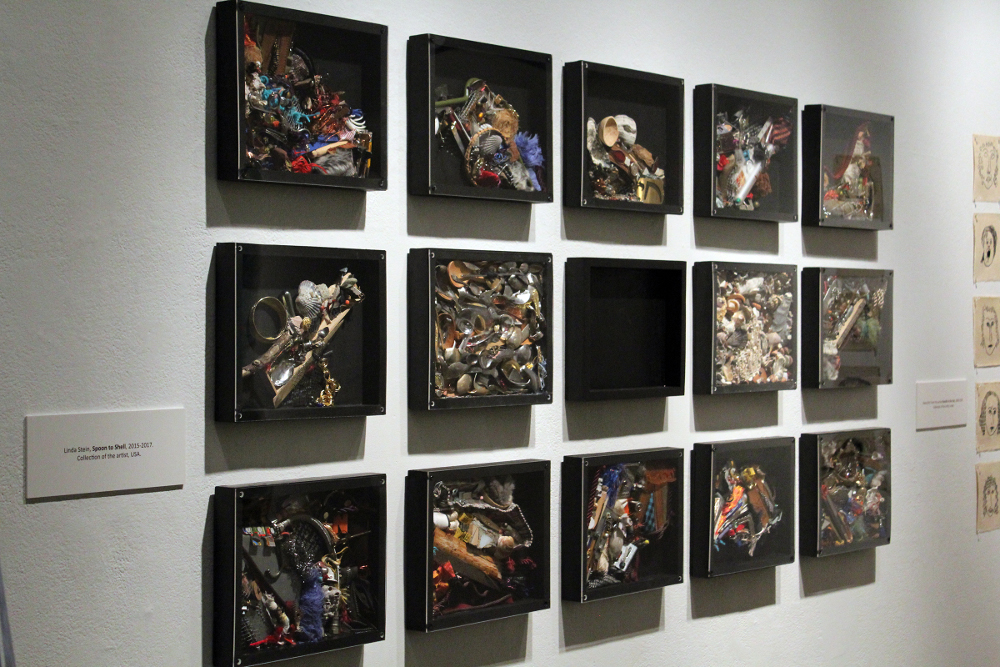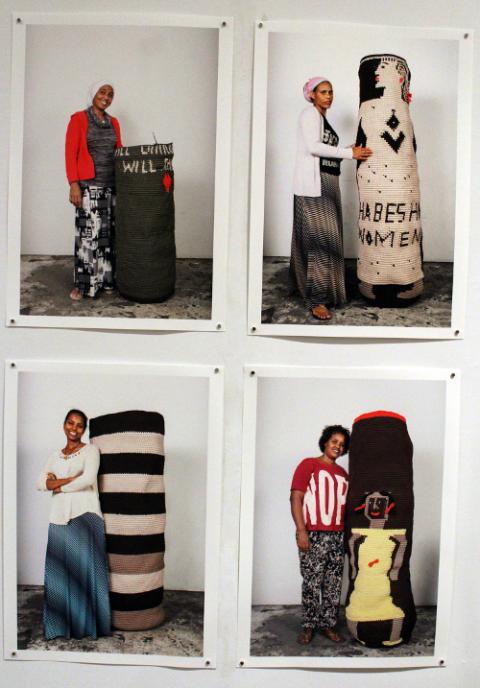
Linda Stein’s mixed-media piece “Spoon to Shell” is part of the “Violated! Women in Holocaust and Genocide” exhibit at the Ronald Feldman Gallery in New York City. (RNS photo by Liz Donovan)
Crocheting is a craft used by artists to make works of art and by artisans to make baskets and clothes. But it also has another purpose, according to the Israeli fiber artist Gil Yefman, "as a means to resolve trauma."
Currently, Yefman's art can be seen side by side with the baskets fashioned by African women seeking asylum in Israel in an exhibition in New York called "Violated! Women in Holocaust and Genocide." The exhibition, organized by the Remember the Women Institute, can be viewed at the Ronald Feldman Gallery in New York City through May 12.
The project showcases artwork made in Israel by African women seeking asylum in that country. They are part of Kuchinate, a collective that helps migrant women, including many victims of sexual violence, earn a living, receive counseling and find healing through art.
"I felt the need to offer them a collaboration because we both do crotchet and we both use crotchet as a means to resolve trauma," Yefman said. In fact, he explained, it's an ideal way to approach serious, harsh topics relating to sexual assault and violation.
The exhibition includes two drawings completed in Nazi concentration camps and incorporates the work of more than 30 artists, including five crocheted towers handcrafted by the Kuchinate women and Yefman. From inside each of those pieces, decorated with crocheted images relating to each woman's experience, a recording of the artist sharing a personal story will play.
Advertisement
The intention is to highlight sexual assault and rape as seldom-discussed aspects of the Holocaust and recent genocides in various countries.
"Women have different experiences than men, and one of them is vulnerability to sexual violence," said Rochelle Saidel, executive director of the Remember the Women Institute.
About 90 percent of the some 38,500 African asylum seekers and refugees currently in Israel hail from Eritrea and Sudan, according to the United Nations Refugee Agency. Others come from Nigeria as well as the Ivory Coast and other areas of Africa. Many of the women who entered the country through eastern Sudan and Sinai Peninsula were victims of torture, sexual assault and human trafficking. Currently, they're facing threats of deportation by the Israeli government.
"I made sure that Kuchinate was born from the desire to provide psychological, economic and social empowerment to women who were in a desperate state of survival," co-founder Diddy Mymin Kahn says on the collective's website.
Kahn, a psychologist specializing in trauma, runs the center with Azezet Habtezghi Kidane, an Eritrean nun who provides spiritual support as well as counseling to the women. Kidane, who's known as Sister Aziza, and Kahn are co-authors of a support manual for torture survivors.

Clockwise from top left: Dolshi Kidane, Achberet Abraha, Zerifea Wolde and Selemawit Hagos, all African asylum seekers living in Tel Aviv, created these four crocheted towers through the collective Kuchinate and in partnership with artist Gil Yefman. (Portraits by Rona Yefman, courtesy of “Violated! Women in Holocaust and Genocide”)
In the exhibit, Saidel aims to show the experiential link among survivors of the Holocaust, refugees and asylum-seekers today.
"The idea of the exhibition is that there is a connection," she said. "First of all, that there was sexual violence during the Holocaust, because there are still people who question that. And it's still going on."
Yefman is hopeful that more women from the collective will be empowered to use their art as a way to share their personal experiences and express themselves freely. He added that the collaboration gave the women the experience of "stepping outside of the collective while creating a better resonance for the collective."
Mostly, though, the women work on the craft as a way to support themselves and their families. At the studio in Tel Aviv, they crotchet baskets and other household objects, like rugs and three-legged stools, which they sell to the public as a way to earn money.
"They're in survival mode," says Kuchinate volunteer Gina Walker, a graduate student at Tel Aviv University studying global migration and policy. "They're very focused on making money to feed the children."
Walker explained that recognizing the struggle of these women, who work in a constant state of instability, is even more important now than ever. "For Passover, we're celebrating our freedom," she said. "These are people who are not free."
Kuchinate is a word for "crotchet" in Tigrinya, a language spoken in Eritrea. The studio in Tel Aviv has become something of a second home for African women seeking asylum.
Sitting on a couch draped in a vivid patterned textile and holding a crotchet needle against a mustard-colored fabric, Favor Agbo closely inspected a half-completed basket. Seeing an error in the carefully stitched handicraft, she seamlessly removed a few inches of string and turned to the woman sitting to her right who had asked for help. When the woman completed the small basket later that afternoon, she held it up triumphantly, inspiring whoops and cheers from around the room.
The collaborative nature of the collective, as well as the soothing act of crocheting itself, enables the women to feel a sense of stability and community. They perform traditional coffee ceremonies for visitors, cook aromatic chickpea-based dishes and speak their own languages. "The money is nothing, but we are happy," Agbo said.




